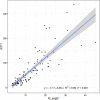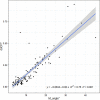Difference of central foveal thickness measurement in patients with macular edema using optical coherence tomography in different display modes
- PMID: 38344662
- PMCID: PMC10853465
- DOI: 10.3389/fendo.2024.1295745
Difference of central foveal thickness measurement in patients with macular edema using optical coherence tomography in different display modes
Abstract
Purpose: To assess the differences in the measurement of central foveal thickness (CFT) in patients with macular edema (ME) between two display modes (1:1 pixel and 1:1 micron) on optical coherence tomography (OCT).
Design: This is a retrospective, cross-sectional study.
Methods: Group A consisted of participants with well-horizontal OCT B-scan images and group B consisted of participants with tilted OCT B-scan. We manually measured the CFT under the two display modes, and the values were compared statistically using the paired t-test. Spearman's test was used to assess the correlations between the OCT image tilting angle (OCT ITA) and the differences in CFT measurement. The area under the curve (AUC) was calculated to define the OCT ITA cutoff for a defined CFT difference.
Results: In group A, the mean CFT in the 1:1 pixel display mode was 420.21 ± 130.61 µm, similar to the mean CFT of 415.27 ± 129.85 µm in the 1:1 micron display mode. In group B, the median CFT in the 1:1 pixel display mode is 409.00 μm (IQR: 171.75 μm) and 368.00 μm (IQR: 149.00 μm) in the 1:1 micron display mode. There were significant differences between the two display modes with the median (IQR) absolute difference and median (IQR) relative difference of 38.00 μm (75.00 μm) and 10.19% (21.91%) (all p = 0.01). The differences in CFT measurement between the two display modes were correlated with the OCT ITA (absolute differences, r = 0.88, p < 0.01; relative differences, r = 0.87, p < 0.01). The AUC for a predefined CFT difference was 0.878 (10 μm), 0.933 (20 μm), 0.938 (30 μm), 0.961 (40 μm), 0.962 (50 μm), and 0.970 (60 μm).
Conclusion: In patients with DM, when the OCT B-scan images were well-horizontal, manual CFT measurements under the two display modes were similar, but when the B-scan images were tilted, the CFT measurements were different under the two display modes, and the differences were correlated to the OCT ITA.
Keywords: central foveal thickness; display mode; macular edema; optical coherence tomography; optical coherence tomography image tilting angle.
Copyright © 2024 Lawali, Wu, Adam, Lin, Kong, Yi, Fang, Niu, Tang, Amza, Zhang, Yu, Yuan and Hu.
Conflict of interest statement
The authors declare that the research was conducted in the absence of any commercial or financial relationships that could be construed as a potential conflict of interest.
Figures






References
Publication types
MeSH terms
LinkOut - more resources
Full Text Sources

